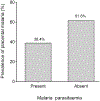Placental Malaria and Its Relationship with Neonatal Birth Weight among Primigravidae: An Analytical Cross-sectional Study
- PMID: 39267914
- PMCID: PMC11391525
- DOI: 10.14218/erhm.2023.00015
Placental Malaria and Its Relationship with Neonatal Birth Weight among Primigravidae: An Analytical Cross-sectional Study
Abstract
Background and objectives: Malaria can be fatal during pregnancy, posing a serious risk to both mothers and fetuses, especially in sub-Saharan Africa. Primigravidae are particularly susceptible to placental malaria in areas with high rates of transmission due to insufficient immunity. This study aimed to determine the prevalence of placental malaria infection, risk factors, types of Plasmodium causing malaria during pregnancy, and its relationship with neonatal birth weight among primigravidae.
Methods: This was an analytical cross-sectional study involving 357 primigravidae who delivered at Abubakar Tafawa Balewa University Teaching Hospital, Bauchi, Nigeria. Placental blocks were taken from the pericentric area of the maternal surface of the placenta, and the birth weights of the neonates were recorded. The samples were fixed in 10% neutral-buffered formalin, and histopathological analysis was performed. The primary outcome measure was to determine the relationship between placental malaria and neonatal birth weight. Demographics and outcomes were analyzed using standard statistical tests. Multivariable regression models accounting for potential confounders were created for the primary and secondary outcomes with adjusted odds ratios as the measures of effect.
Results: The prevalence of placental malaria was 38.4%. Among the participants with positive placenta malaria parasitemia, 49.6%, 36.5%, and 13.9% had chronic, acute, and past placental malaria infections, respectively. Only Plasmodium falciparum was found in the placenta. According to the bivariate analysis, unbooked status (p = 0.001), non-use of intermittent preventive therapy for malaria (p < 0.001), and village dwelling (p = 0.020) were significantly associated with placental malaria. However, on multivariable logistic regression, only non-uptake of intermittent preventive therapy for malaria was independently associated with placental malaria (adjusted odds ratio, 2.2, 95% confidence interval: 1.20, 4.1, p = 0.011). There was a significant difference in the mean birth weight between those with placental malaria and those without placental malaria (2.8 ± 0.5 kg vs. 3.2 ± 0.4 kg, p = 0.001). Additionally, placental malaria was significantly associated with low birth weight among the primigravidae (p < 0.001).
Conclusions: In Nigeria, there is a strong correlation between low birth weight and placental malaria in Primidravidae. Placental malaria was found to be independently correlated with non-uptake of intermittent preventive therapy for malaria.
Keywords: Birth weight; Intermitent preventive therapy; Neonates; Placental histology; Placental malaria; Primigravidae.
Conflict of interest statement
Conflict of interest The authors have no conflict of interests related to this publication.
Figures



References
-
- Megnekou R, Djontu JC, Nana BC, Bigoga JD, Fotso M, Fogang B, et al. Accuracy of One Step malaria rapid diagnostic test (RDT) in detecting Plasmodium falciparum placental malaria infection in women living in Yaoundé, Cameroon. Malar J 2018;17(1):450. doi: 10.1186/s12936-018-2595-8. - DOI - PMC - PubMed
-
- World Health Organization. World Malaria Report. Geneva: World Health Organization; 2018.
-
- Paniker CK, Ghosh S. Malaria Parasites. In: Paniker CK, Ghosh S (eds). Paniker’s Textbook of Medical Parasitology. 7th ed. New Delhi: Jaypee Brothers Medical Publishers Ltd; 2013:66–95.
-
- Sakanari JA, McKerrow JH. Parasitology. In: Brooks GF, Carroll KC, Butel JS, Morse SA, Mietzner TA (eds). Jawetz, Melnick and Adelberg’s Medical Microbiology. 26th ed. McGraw Hill Lange: City published; 2013:727–731.
Grants and funding
LinkOut - more resources
Full Text Sources
Miscellaneous
